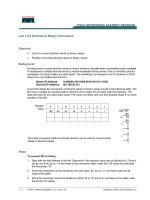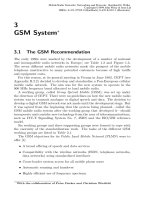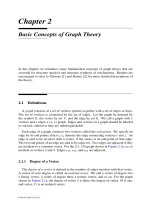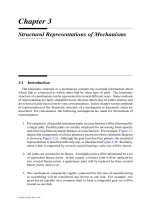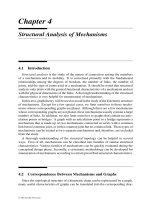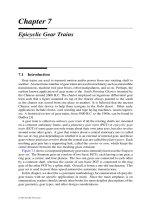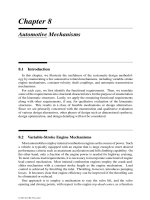Tài liệu Enumeration of Kinematic Structures According to Function P3 pptx
Bạn đang xem bản rút gọn của tài liệu. Xem và tải ngay bản đầy đủ của tài liệu tại đây (1.04 MB, 18 trang )
Chapter 3
Structural Representations of Mechanisms
3.1 Introduction
The kinematic structure of a mechanism contains the essential information about
which link is connected to which other link by what type of joint. The kinematic
structure of a mechanism can be represented in several different ways. Some methods
of representation are fairly straightforward, whereas others may be rather abstract and
do not necessarily have a one-to-one correspondence. In this chapter various methods
of representation of the kinematic structure of a mechanism or kinematic chain are
described. For convenience, the following assumptions are made for all methods of
representation.
1. For simplicity, all parallel redundant paths in a mechanism will be illustrated by
a single path. Parallel paths are usually employed for increasing load capacity
and achieving better dynamic balance of a mechanism. For example, Figure 3.1
depicts the components of a basic planetary gear train whose schematic diagram
is shown in Figure 3.2a. Although the gear train has four planets, the structural
representation is sketched with only one, as illustrated in Figure 3.2b. Similarly,
when a link is supported by several coaxial bearings, only one will be shown.
2. All joints are assumed to be binary. A multiple joint will be substituted by a set
of equivalent binary joints. In this regard, a ternary joint will be replaced by
two coaxial binary joints, a quaternary joint will be replaced by three coaxial
binary joints, and so on.
3. Two mechanical components rigidly connected for the ease of manufacturing
or assembling will be considered and shown as one link. For example, two
gears keyed together on a common shaft to form a compound gear set will be
treated as one link.
© 2001 by CRC Press LLC
FIGURE 3.1
A basic planetary gear train.
3.2 Functional Schematic Representation
Functional schematic representation refers to the most familiar cross-sectional
drawing of a mechanism. Shafts, gears, and other mechanical elements are drawn as
such. For clarity and simplicity, only those functional elements that are essential to
the structural topology of a mechanism are shown.
Two functional schematics representing different physical embodiments might
sometimes share the same structural topology. For example, Figures 3.3a and b show
the schematic diagrams of two different mechanisms. Each of the two mechanisms
contains four links connected by two revolute, one spherical, and one cylindric joint.
The two revolute joint axes in Figure 3.3a intersect at an oblique angle, whereas the
two revolute joint axes in Figure 3.3b are perpendicular to each other with an offset
distance. Both mechanisms are capable of converting the rotational motion of link 2
into the reciprocating and oscillatory motions of link 4. These two mechanisms are
different in physical embodiment, but their structural topologies are identical.
© 2001 by CRC Press LLC
FIGURE 3.2
Schematic diagram and kinematic representation.
FIGURE 3.3
Functional schematics of two RRSC spatial mechanisms.
© 2001 by CRC Press LLC
Similarly, various planetary gear trains with internal versus external gear mesh may
share identical structural topology. Figure 3.4a shows the functional schematic of a
spur gear set with an external gear mesh, whereas Figure 3.4b shows the functional
schematic of another spur gear set with an internal gear mesh. Each of these two
gear sets contains three links. Gear 2 meshes with gear 3, whereas link 1 serves as
the carrier. Together, they form a one-dof gear train. In the side view of a gear pair,
we use two short parallel lines to indicate the gear mesh. These two gear sets are
different in design. However, their structural topologies are identical, to some extent,
as will be described in the following section.
FIGURE 3.4
Functional schematics of two gear sets that share the same structural topology.
© 2001 by CRC Press LLC
3.3 Structural Representation
In a structural representation, each link of a mechanism is denoted by a polygon
whose vertices represent the kinematic pairs. Specifically, a binary link is represented
by a line with two end vertices, a ternary link is represented by a cross-hatched triangle
with three vertices, a quaternary link is represented by a cross-hatched quadrilateral
with four vertices, and so on. Figure 3.5 shows the structural representation of a
binary, ternary, and quaternary link. The vertices of a structural representation can
be colored or labeled for the identification of pair connections. For example, plain
vertices shown in Figure 3.5 denote revolute joints, whereas solid vertices denote
gear pairs.
FIGURE 3.5
Structural representation of links.
The structural representation of a mechanism is defined similarly, except that
the polygon denoting the fixed link is labeled accordingly. Unlike the functional
schematic representation, the dimensions of a mechanism, such as the offset dis-
tance and twist angle between two adjacent links, are not shown in the structural
representation.
Figure 3.6 shows the structural representation of the two RRSC spatial mechanisms
depicted in Figure 3.3, where the edge label denotes the link number and the vertex
label denotes the joint type. Figure 3.6 shows that the four links are connected in a
closed loop by revolute, revolute, spherical, and cylindric joints. We conclude that
both mechanisms shown in Figure 3.3 share the same structural topology.
Figure 3.7 depicts the side view of the planetary gear train shown in Figure 3.2 and
the corresponding structural representation. We note that, at this level of abstraction,
the type of gear mesh is not specified. In this regard, the kinematic structure shown
in Figure 3.7 may be sketched in more than one functional schematic. Either gear
pair can assume either external or internal gear mesh. Hence, there is no one-to-one
correspondence between the functional schematic and the structural representation.
To distinguish the difference requires one additional level of abstraction. For example,
© 2001 by CRC Press LLC
FIGURE 3.6
Structural representation of the two RRSC mechanisms shown in Figure 3.3.
we may use the symbol G
i
to represent an internal gear mesh and G
o
an external gear
mesh.
Figure 3.8 shows the schematics and structural representations of some link assort-
ments frequently used in geared kinematic chains.
3.4 Graph Representation
Since a kinematic chain is a collection of links connected by joints, this link and joint
assemblage can be represented in a more abstract form called the graph representation.
In a graph representation, the vertices denote links and the edges denote joints of a
mechanism. The edge connection between vertices corresponds to the pair connection
between links. To distinguish the differences between various pair connections, the
edges can be labeled or colored. For example, the gear pairs in a gear train can
be represented by thick edges and the turning pairs (revolute joints) by thin edges.
Furthermore, the thin edges can be labeled according to the locations of their axes.
The graph of a mechanism is defined similarly with only one addition; the ver-
tex denoting the fixed link is labeled accordingly, usually with two small concentric
circles. For example, Figure 3.9 depicts a graph representation of the RRSC mech-
anism shown in Figure 3.3. The vertices shown in Figure 3.9 are numbered from 1
to 4 representing links 1 to 4, respectively, and the edges are labeled as R, R, S, and
C according to the pair connections between links.
Similarly, Figure 3.10 illustrates the graph representation of the planetary gear set
shown in Figure 3.2. In Figure 3.10, the thick edges denote gear pairs and the thin
edges denote turning pairs. Since the type of gear mesh is not specified at this level
of abstraction, the graph shown in Figure 3.10 can also represent a gear set with two
external gear meshes or two internal meshes.
© 2001 by CRC Press LLC
FIGURE 3.7
Functional and structural representations of the planetary gear set shown in
Figure 3.2.
The sketching of a graph from a mechanism is very straightforward. However, the
inverse process, that is, the sketching of a mechanism from the graph, requires some
practice to achieve nice proportions. In general, a single graph can be sketched into
several different mechanism embodiments.
Figure 3.11 shows three different kinematic representations of four epicyclic gear
trains.
3.4.1 Advantages of Using Graph Representation
The advantages of using the graph representation are:
1. Many network properties of graphs are directly applicable. For example, we
can apply Euler’s equation to obtain the loop mobility criterion of mechanisms
directly.
2. The structural topology of a mechanism can be uniquely identified. Using graph
representation, the similarity and difference between two different mechanism
embodiments can be easily recognized.
3. Graphs may be used as an aid for the development of computer-aided kinematic
and dynamic analysis of mechanisms. For example, Freudenstein and Yang [7]
applied the theory of fundamental circuits for the kinematic and static force
analysis of planar spur gear trains. The theory was subsequently extended
to the kinematic analysis of bevel-gear robotic mechanisms [12]. Recently,
© 2001 by CRC Press LLC
